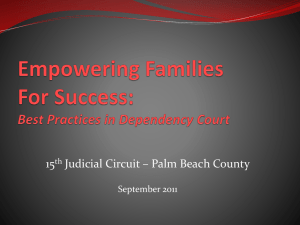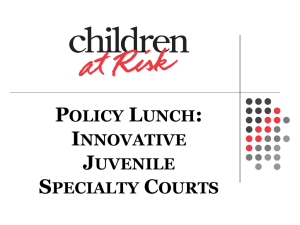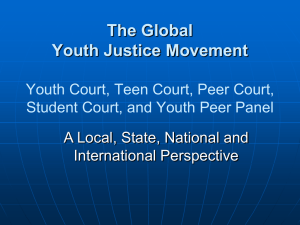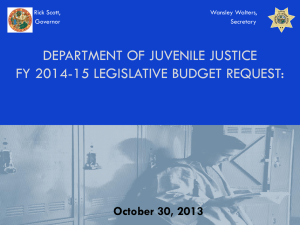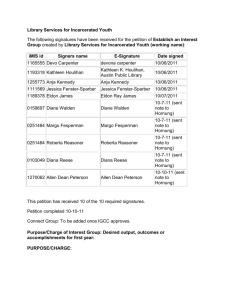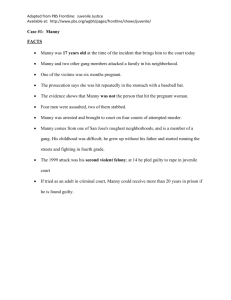No matter how loud I shout: A year in the life of juvenile court.
advertisement
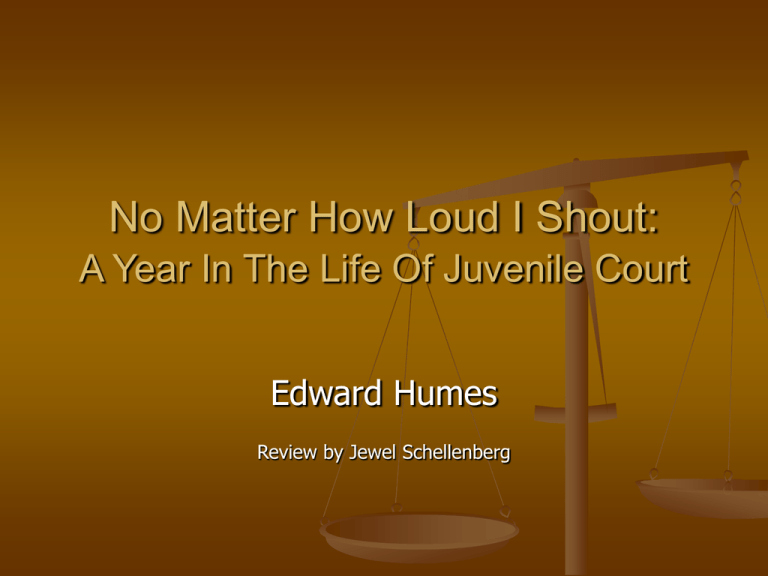
No Matter How Loud I Shout: A Year In The Life Of Juvenile Court Edward Humes Review by Jewel Schellenberg A year in the life… Humes describes the state of the juvenile justice system through his observations of incarcerated youth, judges, district attorneys, public defenders, parents, and probation officers over a year in Los Angeles County, CA. Each individual thrown into the juvenile justice system by way of offense or vocation has a different experience; however, all agree on one thing… It doesn’t work, and I must agree You will learn from the individual stories in this book that the juvenile justice system is far from fair, a youth’s future is essentially determined by: Age What is the least expensive? How busy the courtroom is on any particular day, and The level of concern of the Judge, parents, district attorney, and public defender No consideration is given to the youth – their past, family life, are they a product of the system, have they taken positive steps toward a crime-free life while incarcerated? NO ONE SEEMS TO CARE, and if they do, they feel helpless. Has our educational system failed? One of the biggest predictors of juvenile delinquency is a failed educational experience Judge Dorn in Los Angeles County believes the answer to juvenile delinquency is to “yank kids off the streets and force them to go back into school…go to school or go to jail is the alternative he offers” (Humes, 1996, p. 82). How do we educate youth once incarcerated? Especially as “an estimated 70% of the juvenile justice population suffer from learning disabilities and 33% read below the 4th grade reading level” (Wald et al., 2003, p.11). The court should be a tool for prevention… Meet Judge Dorn Judge Dorn started his own prevention plan in Los Angeles County by reaching out to the community, telling parents, bring in your kids who are disobeying, running away, and skipping school (so-called “status offenses”), he’ll meet with them, essentially a scare tactic to prevent future delinquent behavior How did district attorneys and public defenders respond? They felt Judge Dorn was wasting valuable court time which should be devoted to current offenders and began “papering” him by requesting other judges and continuances, which only served to waste more time and prolong many incarcerated youth’s stays in juvenile hall Desperate parents came from all over the county to see Judge Dorn and “teachers in some of LA’s toughest schools swore Judge Dorn’s kids did better than any other problem student” (Humes, 1996, p. 81). Judge Dorn explains his motivation… “Virtually every adult with a criminal record, virtually every inmate in state prison, virtually every murderer on death row, started their criminal career in the Juvenile Court. Whatever was done with them at that time…way back when they were in Juvenile Court, obviously didn’t work. Why? Because our priorities are backwards” (Humes, 1996, p. 129). Cost Cutting our Youth? (Talk about backwards priorities) The budget of the juvenile justice system is constantly being cut – the programs that prevent are dying Consider the probation department in Los Angeles County which experienced an enormous budget cut: $67 million The department then had to cut intervention camp sentences, some from 8 months to 12 weeks Another great program which places probation officers in elementary and middle schools before they join street gangs has been cut If not prevented... Incarcerated youth are more likely to commit another crime, often more violent, shortly after their release… “Considerable evidence suggests that the detention of juvenile offenders in programs characterized by high exposure to deviant peers and minimal adult interaction fails to reduce, and in some cases may exacerbate, rates of recidivism” (Gifford-Smith et al., 2005, p. 262) How we can learn from the mistakes of the juvenile justice system? Although change is difficult, perhaps we should be more open to intervention and prevention programs such RTI and Positive Behavioral Support plans. We may not see results right away, but in the long run, it will be worth it. Funding is lacking everywhere. Take NCLB – the federal government seems to be asking for miracles, but not providing the resources, should schools teach the tests to achieve AYP? What about those students who get left behind, where will they end up? As educators, we should encourage our counterparts to be aware of behavior problems, and the possible underlying causes. Intervene, ask for help, we can prevent juvenile delinquency before it starts. One final quote… This “is the heartbreak of Juvenile Court, the wonder of it, and the scandal. Heartbreak, because every kid cannot be saved. Wonder, that this broken, battered, outgunned system saves even one child. Scandal, because it so seldom tries to do anything at all” (Humes, 1996, p. 371). Works Cited Gifford-Smith, M., Dodge, K.A., Dishion, T.J., & McCord, J. (2005). Peer influence in children and adolescents: Crossing the bridge from developmental to intervention science. Journal of Abnormal Child Psychology, 33(3), 255-265. Humes, E. (1996). No matter how loud I shout: A year in the life of juvenile court. New York, NY: Simon & Schuster. Wald, J., & Losen, D. F. (2003). Defining a redirecting a school-toprison pipeline. New Directions for Youth Development, 99, 915.
